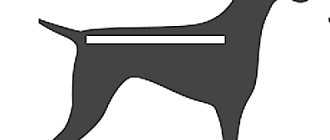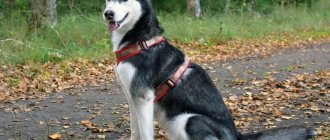In the last few years, future owners are increasingly choosing mongrel dogs as pets, since regardless of the breed or lack thereof, each can turn out to be a loving and devoted friend. But if the type of an adult purebred dog is known in advance, because even if there are small deviations from the standard, you can always imagine what kind of coat it will have, what color, build and, most importantly, what size, then a purebred puppy is always an insignificant pig in a poke.
When choosing a breed, most owners are guided by the size of an adult pet. From time to time, already on the shore, it is clear that the family is not ready to take the blame for the huge dog, since, for example, it needs to be walked for a long time or it will simply be too cramped in the apartment. It also happens the other way around: the dog must necessarily grow to at least a medium size, since there are children or huge dogs at home that can accidentally cause damage to a small pet.
So is it possible to understand how big a mongrel dog puppy will grow?
The path from puppy to adult dog
The growth of puppies occurs unevenly - at each stage, individual parts of the body develop intensively. At first, the puppies rapidly gain height, and later begin to grow in width. This is why babies often look ridiculously disproportionate, and especially their ears, which “become adults” before the rest of the body, protrude.
The foundation for healthy growth of puppies is laid in the first month of their life - with proper development, in such a short period of time they grow 5-6 times! The average weight of a one-month-old puppy is 2–3 kg, while they are born weighing 300–500 g. Fortunately, such sudden changes in weight should not be expected in the future - for example, in the second month, puppies can no more than double in size.
But still they continue to grow intensively - at least in the period from 2 to 6 months; in large and giant dog breeds the growth phase is longer. During this time, the puppy’s weight increases another 3 times, and the limbs increase in approximately the same way. It is interesting that puppies of small and medium breeds are formed more intensively during this period compared to large ones.
After six months, growth rates slow down, although over the next few months puppies can increase their weight by another 25–30%, and their height at the withers by 10%. Thus, by 10–12 months, most puppies turn into full-fledged dogs. If at this stage all family members still fit in the apartment, you can breathe a sigh of relief!
Most dogs reach their maximum height by 1 year of age, but in some breeds this process may take an additional 6–12 months.
Monitor your weight every week
If possible, weigh the puppy at the end of the week for a month and calculate the average gain. Typically, in a week, a puppy who eats properly according to the schedule will gain 250 g. Multiply this value by 52 weeks and add to the current weight. Get the approximate weight of a one-year-old dog. Large dogs can gain a kilogram per week, so at the end of the year you will get at least 52 kg of happiness.
Also watch your appetite. All puppies are constantly hungry, but if your little one eats a meal instantly, looks forward to the next meal, and quickly gains weight, expect a large dog in the future.
How to Determine What Size a Mutt Puppy Will Grow
In recent years, future owners are increasingly choosing mongrel dogs as pets because, regardless of breed or lack thereof, each can make a loving and devoted companion. However, if the appearance of an adult purebred dog is known in advance, because even if there are slight deviations from the standard, you can always guess what kind of fur it will have, what color, build and, most importantly, what size, then a purebred puppy is always a bit of a pig in a poke.
When choosing a breed, most owners are guided by the size of an adult pet. Sometimes, already on the shore, it is clear that the family is not ready to take responsibility for a large dog, because, for example, it needs to be walked for a long time or it will simply be cramped in the apartment. It also happens the other way around: the dog must grow to at least a medium size, because there are children or large dogs at home that can accidentally harm the miniature pet.
So is it possible to understand what size a mongrel dog puppy will grow?
Look at the paws
It happens that the puppy itself is thin, with a small head, but its paws are wide and seem to come from another dog. In this case, most likely, a large dog will grow up. On the contrary, thin, neat legs, proportional to the body, indicate a small size in adulthood.
Pet the puppy. Caress your pet, run your hand over the fur and see how much the skin folds. If this is not a Shar Pei mix, but a decent accordion, we can assume that the skin is genetically laid down “in reserve” and will smooth out as it grows. Accordingly, the more folds, the taller the adult dog will be.
Yard dogs are always a lottery, so the recommendations only give a hypothetical idea of size. It happens that a large-looking puppy turns into a medium-sized dog by the age of eight months and stops growing, while a small and thin puppy continues to stretch out after a year.
Source
Determining the size of a dog by parents
The most reliable way is to look at the puppy's parents. If at least the mother is known, it can be assumed with high probability that the father was approximately the same size as her. And then a simple rule applies: the females in the litter will grow to be the size of their mother, the males will be slightly larger.
Unfortunately, often entire litters of puppies end up thrown out onto the street and it is not possible to look at their pedigree.
Pay attention to proportions
In childhood, all dogs are clumsy and bear little resemblance to strong adult dogs. However, even in infancy, potential is visible in body proportions. Puppies with a large head and a small body, with a wide chest and massive pelvis, and disproportionately powerful paws, are likely to grow large. If the head is proportional to the chest and pelvis, the result will be an average dog. Small ones already in childhood have a body folded like that of an adult dog. The changes will be minor in the shape of the ears and muzzle, but, in general, the dog will remain the same.
How to determine the size of a dog by the age of the puppy
Another option is to calculate his future height and weight based on the puppy’s age and current parameters. On average, all dogs mature in a similar way, going through the same growth phases, so it's easy to know how big your puppy will grow to by knowing how many months old he is.
In the table you will see the percentage of the puppy's weight and height relative to the adult dog.
Find out your date of birth
Ask when the puppy was born and how old he is. Most dogs, regardless of breed, mature and grow within one year. By the fourth month, they usually have 50% of the weight and 80% of the height of an adult dog. By six months they will have grown by another 20-25%. At 12 months they will have grown to 95% of adult size. After a year they continue to grow, but not so significantly.
For example, a puppy weighs 6 kg at four months and has grown to 30 cm at the withers. This means that in two months the weight will increase to 7.5 kg. In a year, the dog will weigh approximately 12 kg and grow to 36-37.5 cm.
All about dog sizes: varieties and methods of measurement
join the discussion
Share with your friends
Depending on their size, there are several types of dogs in the world: dwarf, small, medium, large and giant. Each dog breed is characterized by individual dimensions regarding height at the withers, weight, chest depth. In this article you will learn everything about the size of dogs, as well as how to measure these pets.
What to do if you have a mixed breed puppy
If you have a mixed breed puppy, you may feel like you are completely in the dark about knowing, or even just guessing, what weight your dog should be.
You can do this in two ways. You can take a look at all the weight charts on this page and see which chart is best for your puppy. Or if you wanted to be more precise, use a DNA test to see what breeds your puppy mixes with. Then you will know which puppy weight chart to use.
Wisdom Panel is a simple cheek swab test that will determine which breeds your puppy is crossed with, and there are over 250 breeds, types and varieties of dogs.
It can identify purebred ancestors going back three generations, giving you a good idea of what your puppy's weight will be.
© shutterstock
How to detect the withers
Even owners who have had more than 2 or 3 dogs sometimes have no idea what the withers are and where they are located on the pet. In addition to the fact that the withers are a reference point and a starting point when measuring a dog’s height, knowledge of its location is useful in other cases.
The same applies to the usual treatment of pets' fur and skin against parasites using special drops - the skin on the withers will ensure a gradual supply of the drug into the blood.
The next task that will confront you is to discover this very withers.
For experienced owners, this procedure will take only a few seconds; for those who are encountering dogs for the first time, it should not take even a minute.
Instructions for detecting withers will be located below:
Also, to find the withers, you can use any flat and heavy enough object (to put pressure on the coat). Most often, a small book plays this role.
Place it where you think there is a transition from the neck to the body. If the book takes a position parallel to the floor, the withers have been found.
How to measure a dog's height correctly
The height of a dog at the withers is the perpendicular distance from the place of support (surface - floor, ground) to the point where the animal's neck and its shoulder blades meet. In simple terms, the withers are the highest place on the animal’s body.
When measuring the size of any dog, you should follow a number of rules that will make this process easier.
For large or active breeds, it is worth placing the resulting height marks on a nearby wall or vertical surface, and then measuring this distance with a measuring tape.
In order to understand whether your dog’s size fits into the classic category (proportional ratio of the pet’s height and weight), you should familiarize yourself with the exterior standard for this breed (if we are talking about a purebred individual).
The ICF standard specifies the main appearance characteristics for each popular breed.
How to determine the size of a future dog based on the puppy?
Dog breeders often wonder what size their pet will be when it grows up. To determine the approximate size of a future dog, you should pay attention to the following factors.
To learn how to measure a dog at the withers, watch the following video.
Source











